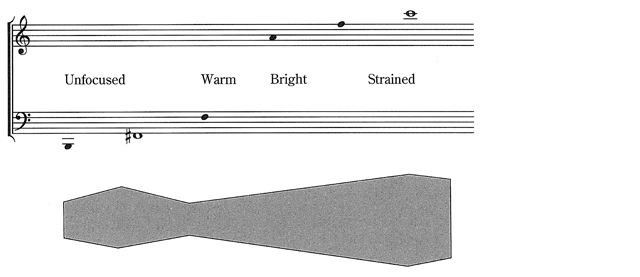Horn in F
IT: corno – FR: cor – GER: Horn
Properties
The horn is a conical coiled tube with a cup-shaped mouthpiece and widely flared bell. The double horn, with three valves, is most common. It is pitched in F, and the thumb operates a valve that changes the fundamental to B♭ a perfect fourth higher. This option facilitates performance in the upper range, where overtones of the shorter fundamental are more easily distinguished.
Range and Natural Dynamics

FIGURE 4.1 Horn range
Transposition
Transpose UP a perfect fifth, writing in treble clef as much as possible. Some outdated notation transposed the part a perfect fourth lower when using bass clef. This method is not used currently, but a note regarding the transposition method used in the score may be added to avoid confusion. The compass is from F# upwards approximately three and a half octaves. The horn is seldom used in its extreme upper or lower ranges.
Tone Quality
The notes are not solid in the lower octave and are easily covered by other instruments. The horn’s presence is felt more than heard in this register. The middle two octaves are characteristically dark and heroic. The higher notes get progressively brighter and sound somewhat forced. The unobtrusive quality of the horn makes it a popular accompanimental voice in the tenor range, but it can become monotonous if overused in this fashion. The upper register is used for solo work.
Technical Abilities
One of the more difficult instruments to master, the horn is not particularly agile. Lip and valve trills are possible but difficult. Wide leaps should be used cautiously, as should fast running passages. Allow sufficient rests for breathing and for relaxing the lip muscles. Intonation and attack depend on the performer’s ability to “hear” the desired pitch, and lines should be smoothly designed. Traditionally, horn players have been more often assigned the fifth of a chord rather than the third in stationary harmonies. A number of challenging solos can be found in the literature for the instrument, such as those written by Richard Strauss in Till Eulenspiegel.
There is a “division of labor” peculiar to the horn section which was used in many 19th century scores. The first and third horns played the higher parts while the second and fourth horns played the lower parts. An interlocking voicing pattern was used when scoring chords for the horns. This practice is not used so much in modern scores. Doubling of pairs is very common, as is the use of a powerful unison for all horns. Another practice maintained in horn sections is the presence of an assistant first player, who may be called upon at any time to share the demanding duties of the first part.


FIGURE 4.2 Ranges and interlocking voicing
Special Effects
Players normally insert their hand partially into the bell, cupping it to control tone quality and pitch. Muting can be accomplished by inserting the hand deeper into the bell, producing “stopped” tones. The notation for this effect is a “+” over the notes. To indicate a return to normal open tones, some orchestrators place an “0” over the notes. Stopped tones are nasal, with an edge to the sound. They are particularly effective when used on forte-piano single notes and in exposed passages. The indication “lontano” asks the performer for a distant-sounding tone.
Musical Examples


FIGURE 4.3 Horn line: Tchaikovsky, Symphony No.5, second movement, measures 8-12


FIGURE 4.4 Horn section: Beethoven, Symphony No.3, third movement, scherzo
